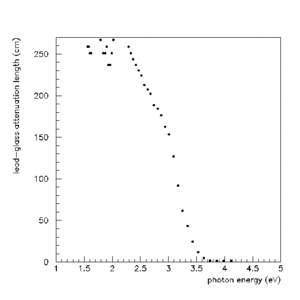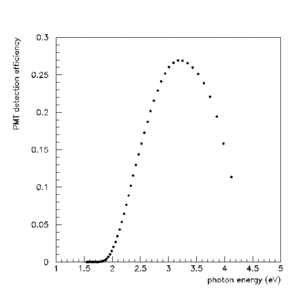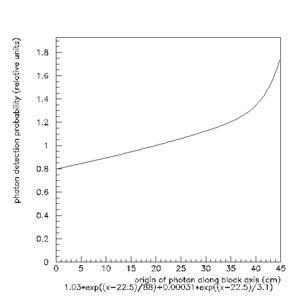Attenuation Results from Radphi
Executive Summary
The final plot (bottom right) on this page shows the effective attenuation length that was determined for Cerenkov photons from normal showers in the Radphi lead-glass calorimeter. The function is a double-exponential fit to MC data. The MC was calibrated using measured spectral functions for all relevant quantities. It shows that the effective attenuation length is around 90 cm for a clean (undamaged) LGD block, much shorter than the naive value of ~200 cm for axial rays.
Discussion
The first plot below shows the measured attenuation length of the Russian lead glass used by E852 and Radphi, and planned for GlueX. The measurements were carried out by S. Teige at UI using varying thicknesses of undamaged material. The second plot shows the quantum efficiency of the photocathode in the Russian PMT's used by E852 and Radphi. These spectral functions are combined with a detailed shower simulation for gammas of normal incidence and energy of order a few GeV to obtain plots 3 and 4. The results are not sensitive to the shower energy above about 100 MeV. In the simulation Cerenkov photons were generated by individual shower particles and each one tracked through the LGD material and either lost, absorbed, or detected on the PMT photocathode. The N0 parameter is a common way to represent the efficiency of a Cerenkov counter, after integration over the Cerenkov spectrum. The N0 of the LGD is plotted in the lower left panel as a function of the shower particle angle with respect to the shower (and block) axis that emitted the light. One can see that photons from axial shower particles cannot reach the phototube because of total internal reflection within the block. The plot shows the radiating particle angle, not the Cerenkov photon angle; the Cerenkov photon angle distribution is shifted to somewhat higher angles peaks in the region 60-70 degrees. This greatly extends the total path length traveled by detected photons. This appears in the effective attenuation curve (final plot) which shows the relative detection probability of a shower particle vs. its emission depth inside the block. The curve is a 2-exponential fit to MC data. The bulk of the distribution has an exponential length of 88 cm.
 Measured attenuation length vs photon energy for Russian lead glass used by the Radphi experiment (eps). |
 Quantum efficiency of PMT used with LGD by Radphi (eps). |
 Cerenkov N0 parameter of LGD from MC Cerenkov simulation as a function of angle of the radiating shower particle with respect to the LGD axis (eps). |
 Effective attenuation curve of LGD in Radphi, from MC Cerenkov simulation, as a function of emission z coordinate along the long axis of the block (eps). |